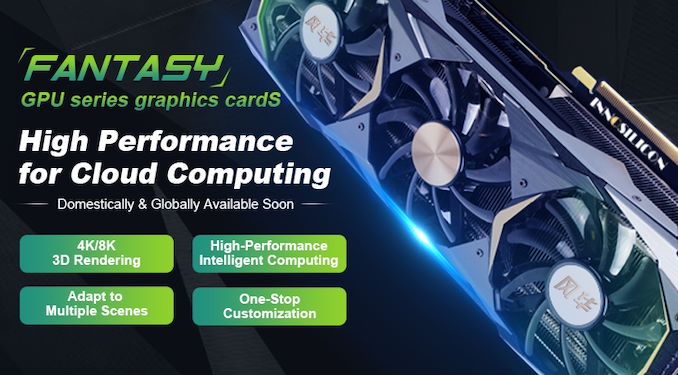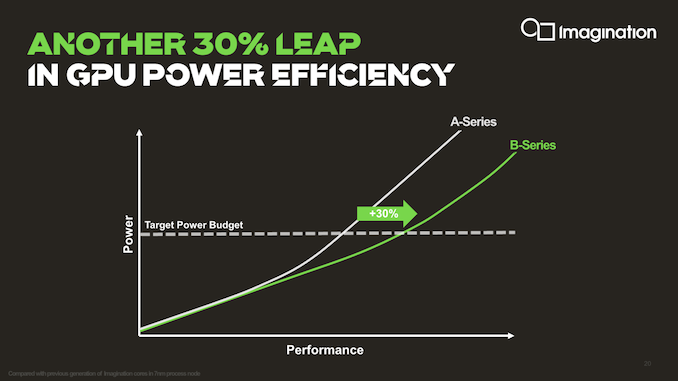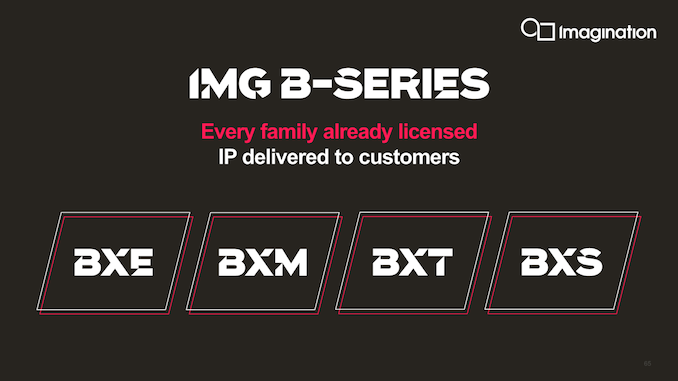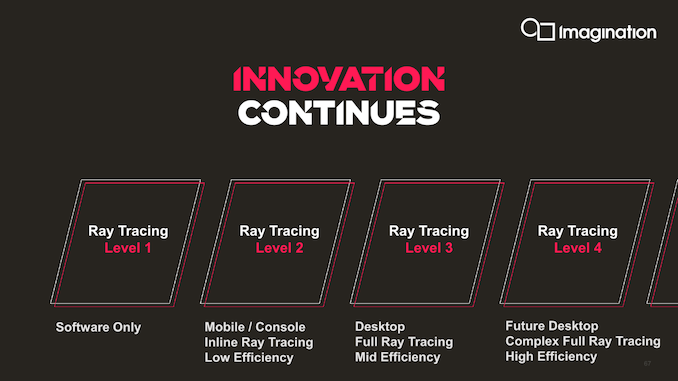Imagination Announces B-Series GPU IP: Scaling up with Multi-GPU
by Andrei Frumusanu on October 13, 2020 4:00 AM EST- Posted in
- GPUs
- Imagination Technologies
- SoCs
- IP
Performance, Efficiency, and a Raytracing Teaser
Overall, today’s announcement of the B-Series has been actually quite exciting. Although the actual GPU microarchitecture has seen only somewhat minor advancements compared to last year’s A-Series, Imagination’s take on multi-GPU is quite innovative and unlike what we’ve seen in past multi-GPU attempts.
The new “pull” decentralised GPU design is certainly something that offers tremendous flexibility. It won’t be something that has absolutely perfect scaling, as there might be some edge-cases where things might get bottlenecked, however Imagination expects extremely good scaling on average.
The B-Series’ roadmapped +30% performance improvement is said to have been achieved through both microarchitectural and physical design improvements (around 15%), with the rest being achieved through the PPA advantage of choosing a multi-core GPU configuration.
Probably what’s more important than the GPU IP itself, is that Imagination says they have actually licensed out and delivered the IP customers already – which is a contrast to past generation Imagination GPU IP announcements where things were publicised ahead of not only the IP being delivered, but ahead of it even being completed.
We still haven not seen or heard of any A-Series design wins, so we do hope there will be more news on that in regards to the B-Series.
Industry sources say that the major demand-driver for Imagination GPU IP right now is the high-performance GPU market in China, where there’s apparently a major hunger and need for domestic designs that are disconnected from US suppliers such as AMD and Nvidia.

Innosilicon Fantasy GPU Series
One such design win is Innosilicon’s recently announced “Fantasy” graphics cards series. Innosilicon to date was known as an ASIC IP design house for various miscellaneous IP blocks, such as providing Nivdia’s GDDR6’s memory controllers.
Roger Mao, Vice President of Engineering, Innosilicon, says;
“Imagination’s BXT multi-core GPU IP delivers the level of performance and power efficiency we had been looking for. Innosilicon has a solid track record in delivering first class high-speed and high-bandwidth computing solutions in advanced FinFET process nodes. Building on this success and strong customer demand, we are announcing our upcoming product which is a standalone high-performance 4K/8K PCI-E Gen4 GPU card, set to hit the market very soon, that will power 5G cloud gaming and data centre applications. With a solid foundation in GDDR6 high-speed memory, cache coherent chiplet innovation and high-performance multimedia processor optimisation, a move into a standalone PCI-E form-factor GPU is natural for us. Thanks to BXT’s multi-core scalable architecture, we are able to build a customised solution to meet the high-end data centre demand with fantastic cloud and computing performance.”
If this pivot towards higher-performance computing works out for Imagination remains to be seen. It certainly seems that at least having a tangible design win such as the above would certainly be a big improvement given that we’ve never seen publicly acknowledged 8XT, 9XT, 9XTP or even A-Series silicon.
Level 4 Raytracing for C-Series
Lastly, Imagination is also teasing their future C-Series architecture, confirming that it’ll be a full raytracing capable design. Although Imagination has had Raytracing IP and capable GPUs for the better part of the decade, it took Nvidia’s RTX series as well as AMD’s inclusion of Raytracing in the new generation consoles as well as RDNA2 series to seriously kick-start the RT ecosystem into gear. Imagination is taking full advantage of this revival as it dusted off its RT IP that previously had been shelved a few years ago.
Beyond confirming that the new C-Series will have ray tracing capabilities, Imagination further confirms that this will be an implementation using the company’s fullest of capabilities, including BVH processing and Coherency Sorting in hardware, a capability the company denotes as a “Level 4” ray tracing implementation, which would be more advanced than what current generation Nvidia and AMD GPUs are able to achieve at a “Level 3”.
Imagination explains that they’ve had these capabilities for a long time, and when discussing with customers as to what kind of capabilities they would like to see in future IP, they had chosen to go for the full-blown implementation as this was the better future-proof design choice.
Overall, it seems like Imagination is on a path where it tries to diversify itself to markets other than the typical low-power GPU use-cases. The next few years will definitely be interesting for the company, and particularly the new distributed multi-GPU approach will be something to pay attention to.














74 Comments
View All Comments
Threska - Wednesday, October 14, 2020 - link
"The MGPU seems like it will be the future of gpu computing, but right now putting multiple slabs of silicon together and efficiently connecting them is expensive and power hungry which is undesirable."https://www.digitaltrends.com/computing/google-sta...
lightningz71 - Tuesday, October 13, 2020 - link
Judging by their past performance with respect to drivers for windows platform systems, I wouldn't touch their desktop products with a ten foot pole until they have thoroughly demonstrated a willingness to:Provide a set of fully functioning drivers
Provide regular updates to those drivers to address bugs and odd behavior
Provide at the absolute least some framework for FOS drivers to be built for Linux
Provide a driver whad for standard linux desktops
Continue to provide these things for a period of several years
Because, up until now, they've done none of the above. Their last desktop product was an integrated gpu for Intel on an early Atom product. They, and Intel, promptly abandoned the product within months of releasing it, and never provided a single functional driver for the very next edition of Windows that was released within six months of the release of that processor. The drivers that were released for the existing windows version had rather basic functionality, were still buggy, and offered no useful video acceleration for any (at the time) modern video compression protocol.
So, they can release it all they want to, but I'm certainly not going near it for a long time.
29a - Tuesday, October 13, 2020 - link
They have tried before but they didn't do very well. I remember this card having a lot of hype before it was released.https://www.anandtech.com/show/735
myownfriend - Tuesday, October 13, 2020 - link
And a lot of people still talk about that card. That was one hell of a review.Threska - Wednesday, October 14, 2020 - link
Had the previous, and yes they were for the time period.Alexvrb - Wednesday, October 14, 2020 - link
The Kyros were great cards for their day, affordable and powerful.Lindegren - Wednesday, October 14, 2020 - link
They did, in 2001 - https://www.anandtech.com/show/735... but they focused on mobile instead, and that is why they are still here, unlike 3dfx and s3
Kel Ghu - Wednesday, October 14, 2020 - link
Imagination Tech's PowerVR tech started on PC. They left the market because their cards were not powerful enough and refocused on the mobile market, where their tech was more power-efficient. It's funny now to hear people asking them to come back to PC. And I'm all for it!myownfriend - Thursday, October 15, 2020 - link
That's not why they left. Imagination doesn't work like Nvidia or AMD. They don't make chips that others buy and place on boards for sale. Imagination makes source code for GPUs and in order for someone to make a graphics card out of it, someone needs to first license that code and make a physical chip.Nobody made a successor to the chip used in the Kyro II so nobody was able to release cards that used anything new after that.
In Anandtech's own article for the Kyro II it shows it outperforming cards that are twice the cost, use the twice the power, and have three times the fill-rate. It's limitation was that it didn't have a hardware T&L unit at the time but the next design would have.
EthiaW - Tuesday, October 13, 2020 - link
Why is the company still making futile investment to large GPUs such as BXT-16/32 without any forseeable customers? Just confused.